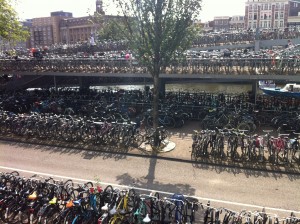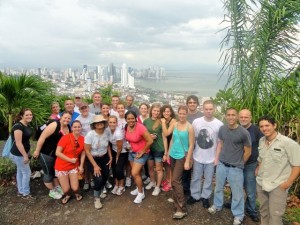This is a post for those UofL students who will be studying abroad this spring and aren’t exactly sure what to bring with you. This is not an exhaustive list by any mean, just a few things that I brought that came in handy when traveling.
Swim Towel – Most hostels will not have towels available for travelers. However, it is often not possible to bring a big towel with you when traveling, as space is a precious commodity. Before leaving, I bought one of those towels swimmers use that you just ring out and it’s instantly dry. You need to keep those towels in their small case, but overall it has served me well and has taken up next to no room in my backpack.
Both a SMALL lock and a BIG lock – Hostels have all different kinds of lockers. Some are big vertical lockers like you would find in a sports locker room; others are ones you pull out from under the bed. The difficult part is that these lockers vary in size and don’t always fit a big combo lock. I brought a smaller lock and a bigger combo lock with me on each trip. I would say half the time I had to use the smaller lock because the combo lock was too big.
Small 3 oz. plastic containers – When flying, you are only allowed to bring liquids that are equal to or less than 3 oz. and these must be put in a plastic see through bag. If you pick up some clear 3-ounce (or less) containers before you leave, you will be able to put shampoo, lotion, or whatever else you need in these smaller containers so you have them available to you when traveling.
Money Belt – This is a super thin fanny pack that you wear under your shirt and basically in your pants that helps protect your valuables from pick pockets. You can put your passport, credit cards, cash and more in here. This way, if the worst-case scenario happened and someone pick pocketed you, they would not get these valuables in your money belt. You can look them up on Amazon.com. I promise you won’t regret this purchase.
Happy packing! – AJ
 People bike starting at a young age because there are no school busses, so that is the form of transportation for young students. It’s not so much a choice of transportation as it is a life style. Here in Holland people bike well into their 70’s and 80’s. Holland is geographically very flat and that combined with their mild summers and winters paves the way for a great biking opportunity that the Dutch have clearly taken advantage of.
People bike starting at a young age because there are no school busses, so that is the form of transportation for young students. It’s not so much a choice of transportation as it is a life style. Here in Holland people bike well into their 70’s and 80’s. Holland is geographically very flat and that combined with their mild summers and winters paves the way for a great biking opportunity that the Dutch have clearly taken advantage of.